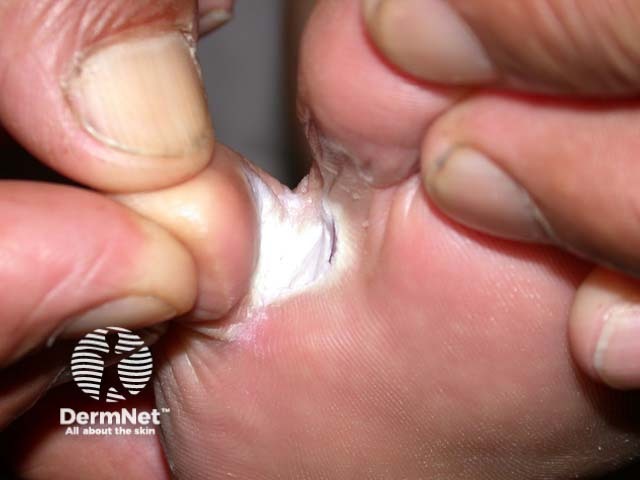Main menu
Common skin conditions

NEWS
Join DermNet PRO
Read more
Quick links
Mixed diagnoses – 10 cases (4 of 11)
For each of the ten cases, study the image(s) and then answer the questions. You can click on the image to view a larger version if required.
Each case should take approximately five minutes to complete. There is a list of suggested further reading material at the end of the quiz.
When you finish the quiz, you can download a certificate.
Case 6

What is athlete's foot?
Athlete's foot refers to macerated peeling or fissured skin, most often between the fourth and fifth toes. It arises in athletes because of sweating, inadequate drying and exposure to infectious organisms. Athlete's foot is provoked by several factors: dermatophyte fungus, yeast or mould infection; bacterial infection (erythrasma, pseudomonas, staphylococci and streptococci); occlusion and pressure (soft corn); injury e.g. over-vigorous removal of peeling skin; skin conditions such as psoriasis, eczema or keratolysis exfoliativa.
What would you advise?
Look for signs of infection, dermatitis or psoriasis elsewhere. In resistant cases, identify specific infection(s) by swabs and careful skin scrapings. Treatment for athlete's foot should begin with general measures. Dry carefully between the toes after bathing; keep toes apart using a cotton or foam wedge. Wear shoes that are loose around the toes or go bare foot; apply a topical antifungal agent such as an imidazole cream or powder. This may also control many of the bacteria responsible for athlete's foot. Whitfield's (benzoic acid compound ointment) is particularly useful as it removes the surface layer of moist peeling skin (i.e. it is keratolytic) and eliminates bacteria and fungi. Make sure that other sites of fungal infection are also treated effectively.
